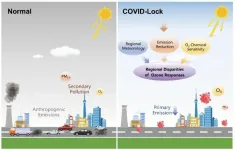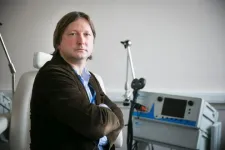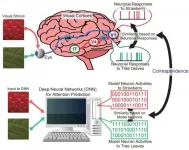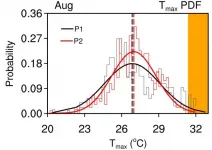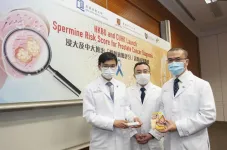(Press-News.org) A way of using machine learning to more accurately identify patients with a mix of psychotic and depressive symptoms has been developed by researchers at the University of Birmingham.
Patients with depression or psychosis rarely experience symptoms of purely one or the other illness. Historically, this has meant that mental health clinicians give a diagnosis of a 'primary' illness, but with secondary symptoms. Making an accurate diagnosis is a big challenge for clinicians and diagnoses often do not accurately reflect the complexity of individual experience or indeed neurobiology.
Clinicians diagnosing psychosis, for example, would frequently regard depression as a secondary illness, with implications for treatment decisions which focus more on psychosis symptoms (e.g. hallucinations or delusions).
A team at the University of Birmingham's Institute for Mental Health and Centre for Human Brain Health, working with researchers from the PRONIA consortium wanted to explore the possibility of using machine learning to create highly accurate models of 'pure' forms of both illnesses and to use these to investigate the diagnostic accuracy of a cohort of patients with mixed symptoms. Their results are published in Schizophrenia Bulletin.
"The majority of patients have co-morbidities, so people with psychosis also have depressive symptoms and vice versa", explains lead author Paris Alexandros Lalousis. "That presents a big challenge for clinicians in terms of diagnosing and then delivering treatments that are designed for patients without co-morbidity. It's not that patients are misdiagnosed, but the current diagnostic categories we have do not accurately reflect the clinical and neurobiological reality".
The researchers examined questionnaire responses, detailed clinical interviews and data from structural magnetic resonance imaging from a cohort of 300 patients taking part in the PRONIA study, a European Union-funded cohort study taking place across seven European research centres.
Within this cohort, the researchers identified small subgroups of patients who could be classified as suffering either from psychosis without any symptoms of depression, or from depression without any psychotic symptoms.
Using this data, the team identified machine learning models of 'pure' depression, and 'pure' psychosis. They were then able to use machine learning methods to apply these models to patients with symptoms of both illnesses. The aim was to build a highly accurate disease profile for each patient and test that against their diagnosis to see how accurate it was.
The team found that, while patients with depression as a primary illness were more likely to be diagnosed accurately, patients with psychosis with depression had symptoms which most frequently tended towards the depression dimension. This may indicate that depression plays a greater part in the illness than had previously been thought.
Mr Lalousis added: "There is a pressing need for better treatments for psychosis and depression, conditions which constitute a major mental health challenge worldwide. Our study highlights the need for clinicians to understand better the complex neurobiology of these conditions, and the role of 'co-morbid' symptoms; in particular considering carefully the role that depression is playing in the illness".
"In this study we have shown how using sophisticated machine learning algorithms which take into account clinical, neurocognitive, and neurobiological factors can aid our understanding of the complexity of mental illness. In the future, we think machine learning could become a critical tool for accurate diagnosis. We have a real opportunity to develop data-driven diagnostic methods - this is an area in which mental health is keeping pace with physical health and it's really important that we keep up that momentum."
INFORMATION:
Notes to editor:
* The University of Birmingham is ranked amongst the world's top 100 institutions. Its work brings people from across the world to Birmingham, including researchers, teachers and more than 6,500 international students from over 150 countries.
The outbreak of COVID-19 raised a question about the relationship between anthropogenic emissions and air pollution, which has aroused heated discussion. Research on air-quality changes caused by the lockdowns in different areas shows similar substantial reductions in primary emissions. However, regional disparities exist in responses of secondary pollutants to emissions reduction, especially fine particulate matter and ozone (O3).
Professor Ding Aijun and his team from Nanjing University explored global air-quality changes during COVID-19 lockdowns and regional disparities in O3 responses to emission reductions. They integrated multiple observational datasets, including global air quality ...
In a new study published in Journal of Extracellular Vesicles, Chen-Yu Zhang's group and Antonio Vidal-Puig's group at University of Cambridge report that pancreatic β cells secrete miR-29 family members (miR-29a, miR-29b and miR-29c) in response to high levels of free fatty acids (FFAs). These β cell-derived miR-29s are delivered to the liver, promoting insulin resistance and enhancing hepatic glucose output.
Over 100 years after insulin was discovered, it was believed that pancreatic β cells only secreted a single hormone--insulin. Pancreatic β cell-derived insulin regulates glucose homeostasis by binding with the insulin receptors located in the liver, skeletal ...
The scientists of Tomsk Polytechnic University jointly with the colleagues from Keysight company have conducted an experiment with an electron beam at the TPU microtron to study a super-radiant regime that occurs when radiation is generated by a train of electron bunches. The research findings obtained by a high-precision measurement of a spectral line width proved that about 8,000 electron bunches in a super-radiant regime form monochromatic Cherenkov radiation. This experiment was conducted for the first time. The fundamental research findings are published in the Scientific Reports academic journal (IF: 4.120, Q1) and can be used for further research on the new sources of radiation in the terahertz range.
A super-radiant regime is a coherent ...
Scientists at HSE University have learned that disagreeing with the opinion of other people leaves a 'trace' in brain activity, which allows the brain to later adjust its opinion in favour of the majority-held point of view. The article was published in Scientific Reports.
We often change our beliefs under the influence of others. This social behavior is called conformity and explains varios components of our behaviour, from voting at elections to fashion trends among teenagers.
Brain research has recently well informed about short-term effects of social influence on decision making. If our choice coincides with the point of view of the people who are important to us, this decision is reinforced in ...
Reston, VA--A combination of radionuclide therapy and immunotherapy has proven successful in slowing the progression of prostate cancer and increasing survival time, according to new research published in the February issue of The Journal of Nuclear Medicine. The results of the murine study indicate that radionuclide therapy promotes prostate cancer immunogenicity, provoking a cellular response that makes the tumors more receptive to immunotherapy.
"Prostate cancer is generally viewed as an immunological cold cancer in which immunotherapies only have moderate success," said Katharina Lückerath, PhD, assistant professor of preclinical ...
Geoscientists have released a video that for the first time shows the uninterrupted movement of the Earth's tectonic plates over the past billion years.
The international effort provides a scientific framework for understanding planetary habitability and for finding critical metal resources needed for a low-carbon future.
It reveals a planet in constant movement as land masses move around the Earth's surface, for instance showing that Antarctica was once at the equator.
The video is based on new research published in the March 2021 edition of ...
This discovery was made possible by applying the research method for the comparison of the brain activity between monkeys and humans to artificial neural networks. This finding might be helpful not only to understand the cortical mechanism of attentional selection but also to develop artificial intelligence.
Deep neural networks (DNNs), which are used in the development of artificial intelligence, are mathematical models for obtaining appropriate mechanisms to solve specific problems from the training with a large-scale dataset. However, the detailed mechanisms underlying DNNs through ...
On Feb 5th, Seoul National University, College of Engineering (Dean Kookheon Char) announced that Professor Sang Woo Seo's research team (Dr. Jina Yang and Mr. Yong Hee Han (graduate student)) at School of Chemical and Biological Engineering has developed a synthetic protein quality control system to enhance full-length translation in bacteria. This technology is expected to increase the efficiency of the production of biopharmaceuticals, industrial enzymes, and bio-based chemicals.
Recombinant proteins are used in various industrial fields from protein drugs such as insulin to industrial proteins such as laundry detergents. Since proteins can perform their functions only with full-length and proper 3D structure, recombinant protein production ...
Against the background of global warming, extreme heat days (EHDs) occur frequently and greatly threaten human health and societal development. Therefore, it is of great importance to understand the variation of EHDs.
Previous studies have indicated that the frequency of EHDs is mainly modulated by the mean state of temperature, and thus the frequency of EHDs mostly presents an increasing trend.
"However, the variability of the daily maximum temperature also plays an important role in the interdecadal change of extreme heat days over Northeast China," says Ms. Liu Wenjun, a Master's student from the group of Dr. Ruidan Chen in the School of Atmospheric Sciences ...
Researchers from Hong Kong Baptist University (HKBU) and the Faculty of Medicine at The Chinese University of Hong Kong (CU Medicine) have jointly developed the Spermine Risk Score which, coupled with the use of a urine test, provides a non-invasive and more reliable method for the diagnosis of prostate cancer. In a study conducted by the researchers, about 37% of the patients, who were ultimately found to have no prostate cancer, can avoid undergoing a prostate biopsy procedure. The findings have just been published in the scientific journal Prostate Cancer and Prostatic Diseases.
Demand for more reliable and non-invasive diagnosis
Prostate cancer is the third most common and the fourth most fatal cancer for the male ...
